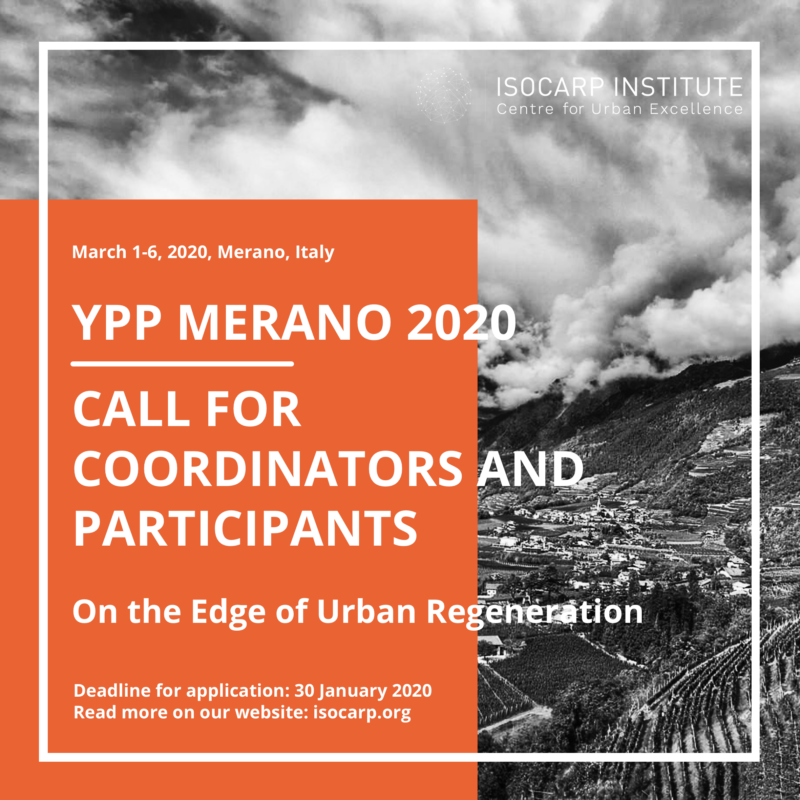Young Planning Professionals’ Workshop
On the Edge of Urban Regeneration
Merano, Italy, 1-6 March 2020
Introduction
ISOCARP is proud to announce a Young Planning Professionals’ workshop (YPP) in Merano, Italy, between 1 and 6 March 2020. The YPP Program is a crucial component of ISOCARP’s dedication to promote and enhance the planning profession and commitment to facilitate knowledge for better cities with the young generations. The Merano YPP Workshop, ‘On the Edge of Urban Regeneration’ is a call for young planning professionals to rethink urban regeneration that transcends the key fundamentals of sustainable mobility, biodiversity, smart city and energy and heritage integrity. It will be organised in collaboration with the Municipality of Merano, EURAC Research, AUDIS (Association of Disused Urban Area Requalification) and the ISOCARP Institute, Centre for Urban Excellence.
Theme of the Workshop
The Merano YPP Workshop, ‘On the Edge of Urban Regeneration’ is a call for young planning professionals to rethink urban regeneration that transcends the key fundamentals of sustainable mobility, biodiversity, smart city and energy and heritage integrity based on the request of the Municipality of Merano.
Heritage integrity
Merano is located at the border with Austria and has been annexed to Italy after the 1st World War. The concept of heritage and identity of the workshop area, former agricultural land, drove around a development hosting Military Barracks since the 1920s. During the last century the area acquired a new identity related to Military functions but also related to shared urban services present in the area also accessible by the citizens like Cinemas and Restaurants. The area it is currently recognized by the citizens as an inaccessible and abandoned area. From the architectural point of view, the area hosts mainly military buildings from the fascist age. The participants are expected to suggest solutions that take into account the history, the heritage and the identity of the area as well different perceptions and memories brought by different stakeholders, while considering the interaction with current real-estate interests for the area.
Biodiversity and ecosystem
The area is 80% covered by green. This is not only because of the low built density but also because of the area’s abandonment for several years, leaving nature to recolonize the territory. From the biodiversity point of view it is an undisturbed area, thus we can expect a high number of species (flora and fauna) and habitats ecologically connected with the surrounding agricultural and mountain areas. The participants are expected to suggest solutions to preserve the richness in biodiversity and ecosystems and suggests how to integrate them with current and future urban functions.
Sustainable mobility
The case study area is strategically located nearby the main connection road and railway line, the MEBO, that connects Merano to Bolzano, the capital of the Province, and to the inner valleys. The MEBO also connects to Austria and Germany. The current situation of the area related to mobility sees the presence of a small network of secondary streets serving mainly the former Military Barracks. At the moment, the area and its streets are not accessible by the citizens. The participants are expected to suggest the possibility to develop a 100% car-free zone or an area accessible by autonomous/electric vehicles and to find out ways to connect this area to the rest of the city and to the main intercity connections at Provincial and National level.
Smart City and Energy
As suggested by the current revision of the Provincial Climate and Energy Plan, Merano should aim to become carbon free by 2030. For this reason the area must be redeveloped taking into consideration the possibilities given by local renewable energy resources and by the state of the art in the sustainable energy production and consumption. In particular, the concept of PROSUMER (producers and consumers) should be used in the scenario development. The participants are expected to suggest how to interconnect ICT, Energy and Mobility to obtain an integrated system able to rely on self-production and consumption of energy but also other ecosystem services like food production, air and water purification, wellbeing etc.
Venue – Merano
Merano is a city and commune in South Tyrol, northern Italy at the border with Austria. The town lies in the heart of the region of South Tyrol on the southern side of the Alps. Generally best known for its spa resorts, it is located within a basin, surrounded by mountains standing up to 3,335 metres above sea level, at the entrance to the Passeier Valley and the Vinschgau. Due to its location, this multicultural city is considered as the gateway to the south of Europe, as well as a meeting place between different cultures. In the past, the city has been a popular place of residence for several scientists, literary people, and artists, including Franz Kafka, Ezra Pound, Paul Lazarsfeld, and also Empress Elisabeth of Austria, who appreciated its mild climate. Merano and its surrounding towns and valleys benefit in many ways from their favorable location. The Merano basin offers a mild climate year round, creating a unique atmosphere where Mediterranean gardens in full bloom sit beneath snow-covered Alpine peaks. This mixture of Germanic and Italian culture has also led to a specific local cuisine characterized by both Mediterranean and Alpine traditions. For these reasons Merano has a flourish touristic economy that counts about 450.000 overnight stays per year.
Case study area – Demanio Militare
The area subject of the intervention is located in the south-eastern part of Merano and measures about 0.65 km2 for a perimeter of about 3300m. The area is currently owned by the Demanio Militare (Military Barracks), but there are disposal procedures in favour of the Autonomous Province of Bolzano and subsequently the Municipality of Merano. The area has been developed in the 1920s to host Military Barracks after the World War I, when Meran (former Austria) became part of Italy. The study area is particularly important for several reasons:
Currently the area is abandoned, inaccessible and enclosed by a 2.5 meter high wall. Inside the area there are several built volumes, former barracks that can be retrofitted or designated to urban destinations. The identity of this area is controversial, as it was former agricultural land afterward ‘occupied’ by military functions. Its counts for about 1/10 of the total urbanized area of the municipality. It is strategically located along the main road connection and the railway line. It is flat, green and abandoned. It host a high level of biodiversity. The Municipality wants to develop this area in line with sustainability criteria and Considers the destiny of this area of absolute importance for the future development of the city.
Application deadline: 30 January 2020 (11.59 pm UTC). Please read the Calls for Coordinators and Participants before applying!
Call for Coordinators
Call for Participants (Online Application Form for Participants)
If you have any question regarding your application, please contact Zeynep Gunay, ISOCARP Board Member Director for YPP via gunay@isocarp.org.
Partners

